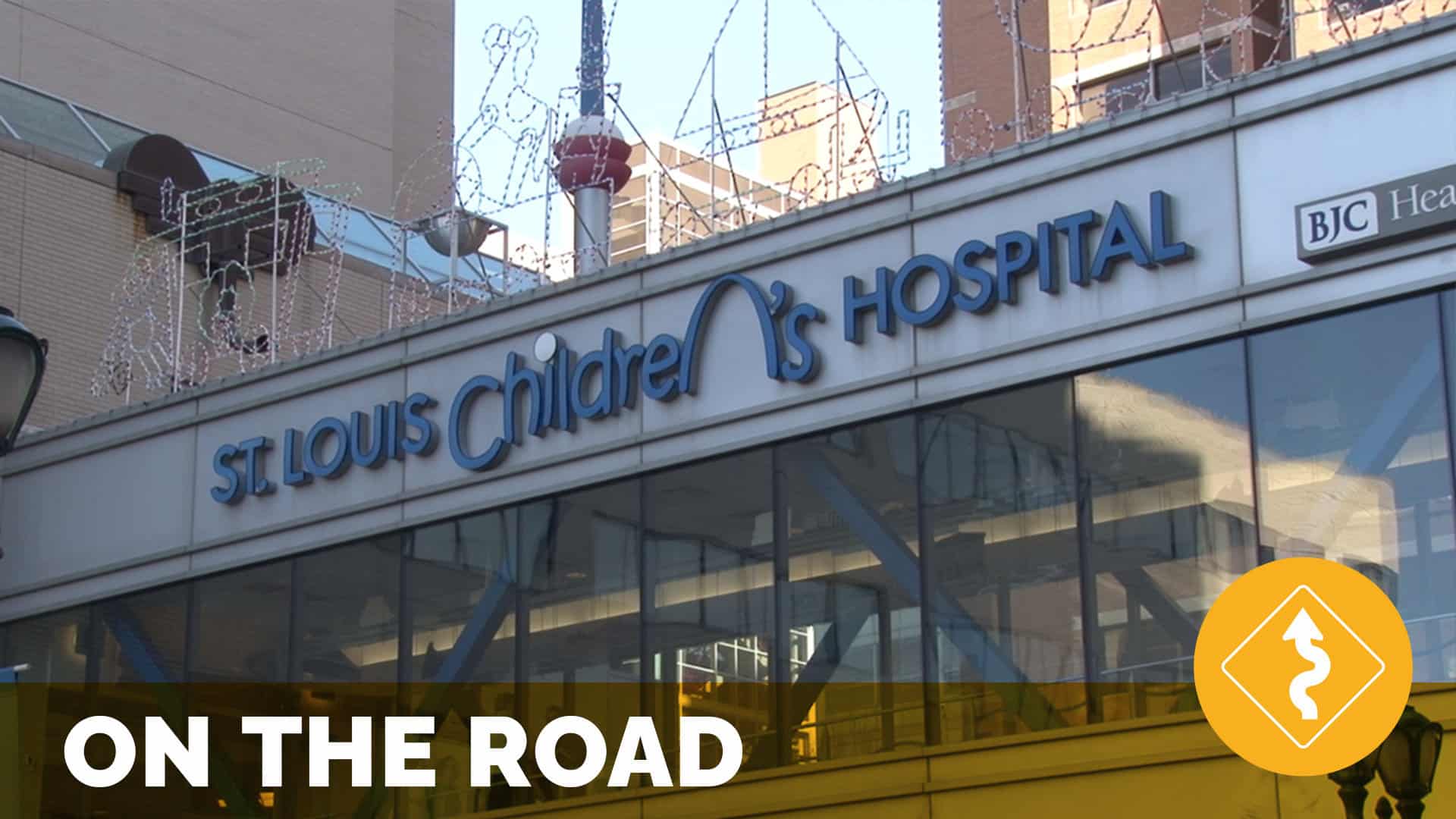Doing What’s Right For Kids

On the Road with St. Louis Children’s Hospital – May 2012
by Jason A. Wolf
Our May On the Road took me to the “Gateway to the West”, St. Louis, and specifically St. Louis Children’s Hospital. My host, Joanne Buttice, Director of Guest Services, planned a journey through the facility to engage with leaders, caregivers, volunteers and other team members. These individuals graciously shared their story from in their units, resource centers, playrooms and even gardens. My visit and the passion and commitment of the individuals with which I met can perhaps be summed up in my closing question to a team of leaders, “if I were to take one thing away what would it be?” The response was unanimous and powerful; “At St. Louis Children’s Hospital, we do what is right for kids!”
My visit started with a discussion with members of the senior leadership team including Dr. F. Sessions Cole, Chief Medical Officer, Peggy Gordin, VP, Patient Care Services, Gary LaBlance, VP, Quality, Service, Information Management, Russell Hoffmann, Director of Cultural Transformation, and my host Joanne Buttice (pictured right). These individuals framed the efforts at St. Louis Children’s Hospital, introducing me to their Superior Patient Experience effort. This has been an intentional part of the facility’s language and strategy for the last few years, and is garnering greater attention as more staff members engage in the effort.
Superior Patient Experience (or SPE as it is called) consists of three drivers – safe care, effective care and exceptional service. Peggy Gordin reinforced, “The key for St. Louis Children’s Hospital is that care and service go hand-in-hand”. It was also evident that this effort must be both consistent and constant. “The focus for our team is ‘every patient, every family, every day’”, added Russell Hoffmann. As part of an academic medical center and being a teaching hospital this presents complex opportunities, which is why the simplicity of the message is both important and profound. Creating alignment around this core focus was a center-point for these leaders and it was clear as I began my exploration that this commitment permeated the hospital.
Structural Opportunities for Success
My visit took me through a number of units and provided me the chance to engage with staff at all levels. Across my conversations, four practices emerged as key to driving the Superior Patient Experience effort. I name these structural opportunities as they all add a formal or informal element to the operational efforts of the facility. They also have resulted in a significant sense of ownership, shared communication and the ability to engage great numbers in implementing new ideas or making change. The team also acknowledged these efforts are works in progress, but their application and concept are great models to consider across all healthcare settings. They included:
Informal Leaders
Informal Leaders is a powerful process through which individuals are recognized across the facility’s units and departments. Informal leaders are not directors or managers, but rather individuals identified and recognized for the impact they have in the facility. These individuals are trained on the core ideas of the Superior Patient Experience and then bring these ideas and other information back to their specific areas. This alignment around a common language, focus and purpose helps ensure the facility as a whole is focusing on the right things. “This process provides for not only the ability to share information more broadly through the organization, but instills pride, expands appreciation and recognition and increases a sense of personal ownership,” said Cathy Madonna, RN (pictured with members of her team left). Informal leaders can acknowledge people in the facility for contributions to SPE or other positive performance. They also help bring key messages to the floor. In addition these individuals connect with one another, which helps to break down silos across departments and create a greater sharing of information and ideas. Informal leaders do not get a badge, pin or even a special t-shirt. Their acknowledgement comes in the recognition that individual leadership at all levels at St. Louis Children’s Hospital ultimately drives their success.
Unit-Based Joint Practice Teams
Another practical program with a critical eye on engaging staff and physicians is Unit-Based Joint Practice Teams. These teams provide an opportunity for collaboration and planning in each unit, bringing together physicians (including residents), nurse managers, front line staff, family members, and including representatives from other areas in the facility such as pharmacy, education, quality, etc. These teams all take on the flavor of their unit, but as Michele Lane and Kara Nichols, both nurse leaders and Dr. Chrissy Hrach, a physician leader shared, (pictured right) they become critical work groups for not only sharing information, but also for planning and addressing specific issues facing the unit. By having all the players collaborating at the unit level, opportunities are identified in real time and shared decisions are made that engage all areas that work on or serve the unit. While focused at the unit level these teams also have global impact as new ideas are shared across teams, creating a greater percolation and implementation of innovative practices all generated by the people within the facility. The premise of all of this work envelops the patient experience – safe care, effective care and exceptional service.
Volunteers as Ambassadors
I know some may ask what is so unique about volunteers, as most facilities engage some sort of volunteer pool every day. While perhaps unique due to the pediatric setting, I believe all healthcare organizations could learn about moving beyond volunteers to the idea of ambassadors. Ambassadors at St. Louis Children’s Hospital are not there directly for the patient. Jill Mechler, Manager, Guest Services, shared, “Ambassadors are here to help the adult family and siblings of patients. They exist to know what is available at all times to support a family’s experience.” There is still an army of volunteers managed by the Guest Services team (pictured left) that covers everything you would expect from playing with the kids to other traditional patient support roles. What the lesson is here is that even when we use the succinct term “patient experience”, it is inclusive of the patient, their family and support network. What may seem more obvious in pediatric settings is that family members have as significant a role as patients and may often be the ones more aware and/or concerned, which raises the need for support of their own. The opportunity this presents is finding ways to take better care of those around our patients across all healthcare settings.
Employee Resource Allocation Committee
Jeff Johnson, Director of Operations, St. Louis Children’s Foundation, shared a unique addition to the SPE effort. The Employee Resource Allocation Committee, or ERAC, is an actual team of twelve staff members from across the facility that convenes to review and provide grants for efforts committed to support the Superior Patient Experience. It is supported annually by $25,000 from the St. Louis Children’s Hospital Foundation. Employees, or teams of employees, can submit a proposal that is reviewed by the ERAC team and then supporting funding may be awarded. This process has fostered a number of interesting outcomes. It has provided a new sense of ownership for those on the Board as they determine what would be the best use of the facility’s financial resources. It has also led to the incubation of innovative ideas that have had positive impact on the overall experience of patients and families. Again through creating an opportunity for individual leadership and ownership, new opportunities can come to life.
An Environment of Support
While this On the Road was full of very clear structural insights, there were also a number of environmental factors that clearly play a role in the Superior Patient Experience efforts at St Louis Children’s Hospital. These are more than just the look, feel and touch of a children’s facility, which tends to create a more welcoming environment, bright colors and other means by which to create comfort for patients and families. For example, a large picture of the facility mascot, Snerdlihc (yes, that is Children’s backwards) greets people as they arrive (pictured right). Instead an environment of support is the spaces, places and additional considerations to ensure the best experience possible for patients and families.
A Place for Healing
St. Louis Children’s Hospital may have one of the most incredible hidden gems I have experienced in a healthcare facility of any type. The Olson Family Garden is a rooftop oasis (pictured below) of over 8000 square feet comprising numbers of flowers and plants, water features and paths and many special features designed to both engage and comfort patients and their families. Gary Wangler, Horticultural Therapist, who cares for the garden emphasized, “This is more than just a pretty space, it is a place for healing, a place for learning and a place for finding peace.” The garden hosts a number of events for patients and their families from music to art to nature and serves as the perfect reprieve from the day-to-day activity just inside the doors of the facilities eighth floor. It is definitely more than just a healing garden, it is truly a wonderland and an example of how the patient experience happens in the places you least expect.
A Place for Learning
While the garden is a public space, another equally impressive component hidden in the building is the Saigh Pediatric Simulation Center. A place for learning in real time, the simulation center provides student nurses, residents and staff the chance to practice in real-life situations as they learn or refine skills in caregiving. The power of this center from the perspective of patient experience is not just its clear impact on the safe and effective care components of Children’s Superior Patient Experience, but also on the exceptional service component as well. Through the use of volunteer family members, students and staff can play out actual scenarios to the full extent, where there is not only a medical issue to manage, but also “actual” family members or loved ones in the room. Simulation is not just about the protocols of care; they train, test and reinforce the interactions that are central to ensuring the best experience possible.
A Place for Supporting
One aspect of guest services stood out and while not necessarily unique to St. Louis Children’s Hospital, its application in the care environment stood out. The Family Resource Center (FRC) is bustling with activity. Staffed with pediatric nurse educators, a consumer librarian and volunteers that can help parents and families find the information they need, the FRC plays an active role in the patient and family experience. Staff on the floors can actually request information directly from the vast numbers of resources available at the center through a patient’s electronic health record. The moment it is entered, it notifies staff at the center that gather resources and it is then immediately delivered to the bedside. This seamless effort ensures patients and families have the information they need, but also experience the care and service the team at St. Louis Children’s Hospital strives to provide. Aside from typical resources for patients in the facilities, the facility decided to house a DVD entertainment library within the center as well. This has created a greater flow of traffic and interaction with the center’s services, which aside from information sharing, serves as a business center, including notary services and as a general support location for parents and families. Made possible through support from the St. Louis Children’s Hospital Foundation, the center is not just an internal facing resource. The team actually makes themselves available as an educational resource for pediatric care to anyone who calls. As Joanne Buttice shared, “This is a service we believe is a critical part of our mission of ‘doing what’s right for kids’ and thus our Superior Patient Experience. To support that commitment, this totally free resource is all inclusive and available to all, no exceptions.” This has shown itself to be true. In tracking the interactions with the center they received inquiries from all 50 states last year, providing the same level of service and commitment to those thousands of miles away as they continue to do for families within their walls.
A Place for Playing
When we think about patient and family experience we tend to focus on those receiving direct care and the loved ones at the bedside. In the pediatric environment, the picture expands as child and teen patients often have siblings who are impacted by the situation as well. While these individuals, namely the younger ones could stand by in a patient’s room with their parents or family members, St. Louis Children’s Hospital provides them an outlet, called the Sibling Playroom, a supervised space for sibling ages 2-11. Jill Malan, Manager of Child Life Services shared (pictured left), “Not only does this place provide a reprieve for siblings who may be overwhelmed or even unaware of the situation their sibling is facing, it also allows parents to focus on their sick or healing child while knowing that their children are being cared for nearby.”
To bring joy in a place that could be otherwise scary or confusing is a powerful acknowledgement that patient experience truly touches every aspect of what patients and families encounter across the continuum of care. Jill offered that the intention of all of the Child Life Services offered at Children’s are focused on, “making what could be a scary place normal.” One point of note was what made this playroom possible. Recognizing the need to ensure this part of the experience was addressed, staff members from Children’s initiated a fundraising drive to support the conversion of what was a underutilized conference room into a real retreat for children. My visit to the playroom was complete when I also got to meet two of the five “Clown Docs” that travel the halls and spaces of the facility. As she was being picked up by her father, one young sister of a patient wanted to make sure I saw them, “Did you see the clowns?” she asked with a smile. “He gave me his nose,” she added laughing as she showed me the red ball nose she now was trying to stick on her father.
Providing Choice and a Sense of Control
I have seen room service options in the adult acute care setting, but rarely in the pediatric environment, let alone one with a theme that changes the entire dining experience. Moose on the Loose does just that. By providing dining choice and options for patients, they are given a greater sense of control in an environment in which they may feel they have no control at all. The opportunity to choose your meals is one thing; it is quite something else for your food to be delivered by a park ranger in their Moose on the Loose uniform. Here, dining choice and delivery is an experience itself, and it reinforces that the patient and family experience happens in every interaction we create in a healthcare facility.
I had the privilege to dine with facility leaders including Executive Chef Robert Grotha (pictured above), whose recognition of his team’s role in the experience was clear. He explained that for his team, “It is a privilege to cook for the children and families that enter their facility.” He reinforced that Moose on the Loose was more then just dining, it provided a sense of comfort in what can be an overwhelming situation. This is the true acknowledgement that everyone that delivers or supports patient care in the healthcare environment is the patient experience (See the video “I am the Patient Experience”)
Doing What’s Right for Kids
A short article can never do justice to the many amazing things shared during an On the Road visit. What was clear is that at St. Louis Children’s Hospital there was an understanding that “Superior Patient Experience” was not just a phrase everyone needed to know, it represented the actions, interactions, efforts, processes and protocols all aligned with ensuring safe care, effective care, and exceptional service for every patient, every family, every day. The team also acknowledged this was still a work in progress which Joanne reinforced as I was leaving, “While we may not be perfect, we are engaged and with high energy embrace this journey every day.” I reiterated that those facilities that never stop trying are the ones I see truly making a difference.
Making a difference is key and one of my takeaways from this On the Road visit was that leaders in the adult setting could learn a thing or two from their colleagues in pediatrics. There are huge opportunities to create environments that support experience and healing, not just by reducing noise or providing private rooms, but rather by bringing the whole person (versus just “the patient”, i.e. their diagnosis, etc.) back into patient experience efforts. Chef Grotha may have summed this up best as we were saying goodbye, when he said, “It is our patients that truly provide the inspiration for what we do here. We may have helped them, but it is they that inspire us to do what we do each and every day.”
Related content
-
 Culture & Leadership | Infrastructure & Governance
Culture & Leadership | Infrastructure & GovernancePhoneside Manners: Strategies for Effective Communication
As the first point of contact that a patient has with your office, what transpires after the phone’s first ring can set the tone for the entire patient experience and impact patient satisfaction. Phoneside manners occur before a patient even walks through your front doors and can determine the outcome, mindset, and overall satisfaction of
Learn more -
 Culture & Leadership | Quality & Clinical Excellence | Staff & Provider Engagement
Culture & Leadership | Quality & Clinical Excellence | Staff & Provider EngagementDeveloping an Interactive Behavioral Based Training Program
This webinar, How to Develop an Interactive Behavioral Based Training Program that Aligns with Employee and Patient Feedback around Improvement Opportunities, will provide step by step guidance to develop a training program with a focus on behavioral based learning. The program uses storytelling and staff and patient feedback to “connect the dots” in the human
Learn more -
 Environment & Hospitality | Quality & Clinical Excellence
Environment & Hospitality | Quality & Clinical ExcellenceThe Impact of Adverse Childhood Experiences in Pediatric and Adult Healthcare
2pm ET / 1pm CT / 12pm MT / 11am PT – Being a pediatric patient in healthcare can be filled with misconceptions, anxiety, and distress. The adverse childhood experiences that may occur not only impact the pediatric healthcare experience but coping with healthcare experiences well into adulthood. This webinar will discuss adverse childhood experience
Learn more
